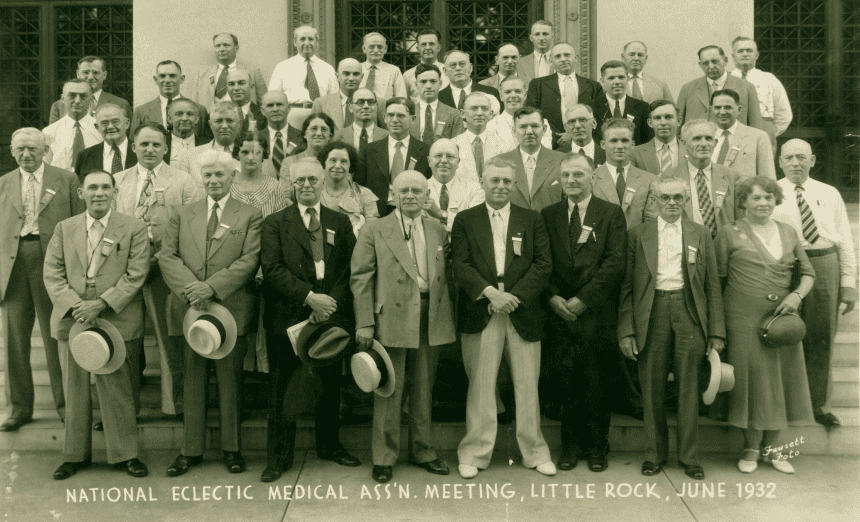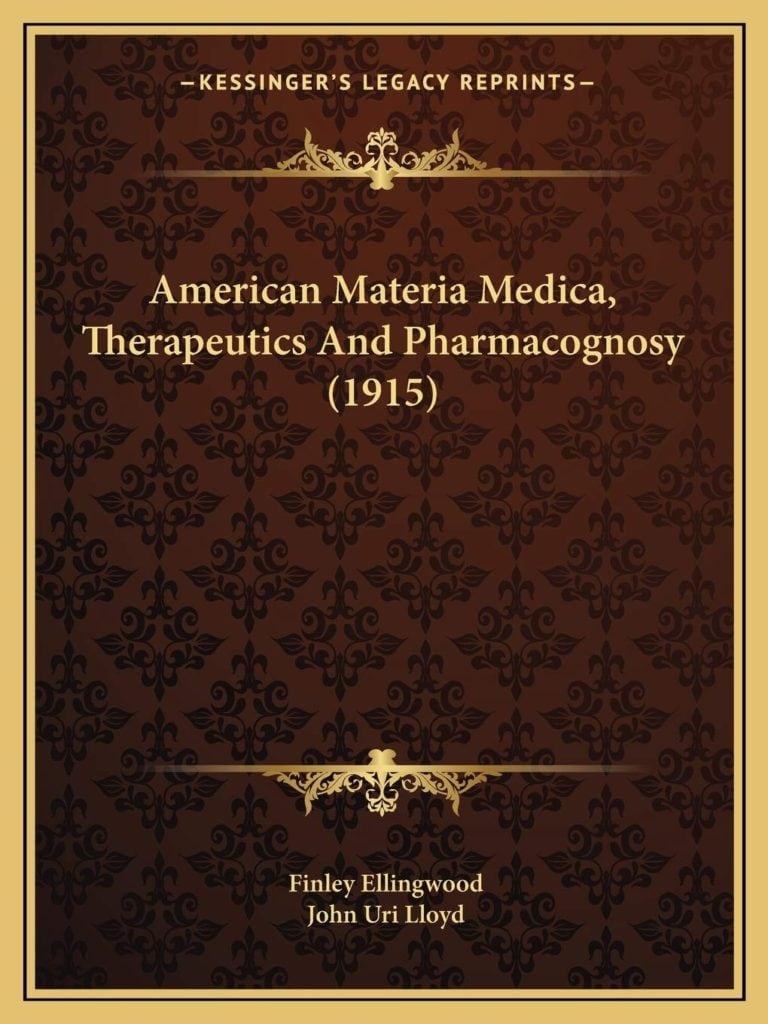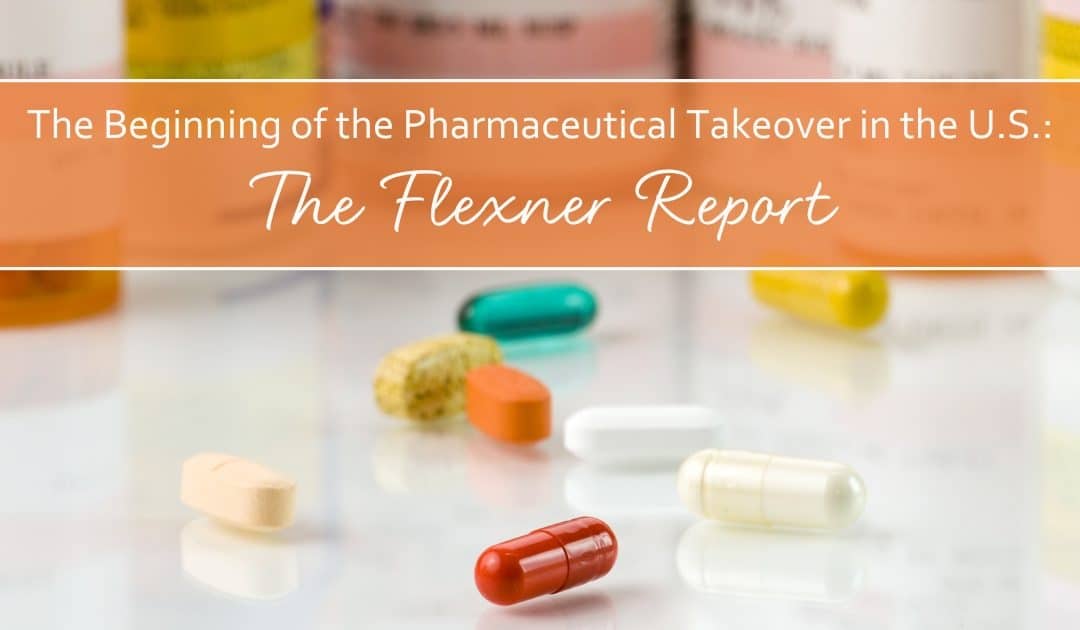Have you ever wondered why herbs are deeply woven into medical institutions in many places including China, India, Germany and Japan, but often dismissed as ineffective in North America, where taking a pill is suggested at every turn? Or if you do mention an herbal adjunct therapy to your doctor, you are met with dismissal or even belittling comments?
The disregard for integrative medicine is one hundred years in the making and we are still suffering the effects of a medical school review published more than a century ago.
Enter… the Flexner Report.
Have you heard of the Flexner Report? Read on, because being empowered with this piece of history that helped gut our medical choices, is part of how we bring balance back into what is considered “medicine” in the United States.

We have to know where we come from to change where we are going. What was the intention behind limiting the medical choices we have available in US mainstream medicine?
Holistic models of medical treatment can be found all over the world and the Flexner Report is key to understanding how we in the United States lost access to holistic medical options.
Here is a story of the efforts of a few players who drastically altered the path of medicine in North America based on personal gain and profit.
What is the Flexner Report?
The Flexner Report – actual title “Medical Education in the United States and Canada” but nicknamed for its author, Abraham Flexner – was an in-depth assessment of 155 medical schools in the US and Canada. It was commissioned by the American Medical Association, funded by the Carnegie Foundation, and penned by Flexner, who visited each of the schools.
Published in 1910, the Flexner Report would redefine medical education in North America, putting a stranglehold on what could be taught in medical schools. With the stated goal of creating more uniform standards in North American medicine, it established the biomedical model as the sole legitimate form of medicine and contributed to the eventual closure of schools that did not meet its standards.
“Being empowered with this piece of history that helped gut our medical choices, is part of how we bring balance back into what is considered ‘medicine’ in the United States.”
Even if you’ve never heard of the biomedical model, it has almost certainly influenced the way you think about health and medicine. The biomedical model seeks to understand disease at the microscopic level, centralizing the body’s structure and the impact of pathogens.
Under the biomedical model, drugs are often designed to suppress symptoms through molecular interactions. You attack the specific symptom without regard for affect on the rest of the body. Thus, the current rampant statistics of iatrogenic disease. Iatrogenic disease is an ill effect that is caused by a medical procedure or substance used to treat symptoms but causes a secondary illness. (Side-effects anyone?)

Flexner Report bottom line, if your medical school was focused on teaching pharmaceuticals and surgery, you were in. Herbs, nutrition, water cures, thousands of years of empirical evidence about which food and herbs to use when… nope, not good enough, time to close the doors and suppress all knowledge not in line with the narrative.
Before the Flexner Report
Prior to the 1910 report, medical colleges that focused on herbalism and holistic health flourished in the United States, although they wouldn’t have used the words “herbalism” or “holistic health.”

Doctors practicing in what was called the “Eclectic” tradition used knowledge of plants drawn from various sources, including European and Native American folk medicine, to help patients. There were schools of hydrotherapy using ancient knowledge of how to heal with water along with homeopathic colleges using plants and minerals to activate the body’s innate healing power.

Eclectic medicine, which continues to influence North American herbalism, was popular in the late 1800s and early 1900s. The name comes from the Greek eklego, “to choose from,” because these doctors drew on plants, physical therapy, and other remedies to bring their patients into a state of health.
Eclectic medicine was focused on strengthening the whole person with natural means instead of using drugs to kill a pathogen without regard for its effect on the overall health of the person.
Think of the drug commercials on T.V. Sunshine and rainbows are how you feel while suppressing a certain symptom with a new drug. And then at the end you hear the litany of possible side effects that include even death.
One of the Eclectic movement’s leaders was John Uri Lloyd, a pharmacist whose practice was infused with ethnobotany and herbalism. His extensive research into the medical use of plants shows how vastly the pharmaceutical industry has changed since the early 1900s. His name will come up again in this post – he helped fund the Lloyd Library and Museum, which houses publications of the Eclectic physicians and medical schools.

My beloved teacher and Herbalist Michael Moore credits the American School of Medicine for training Eclectic physicians in the US The Ohio-based Eclectic Medical Institute graduated its first class in 1833 and its last in 1939.
It’s hard to imagine that a century ago, those looking to become doctors could choose from an array of medical philosophies: Eclecticism, homeopathy, hydrotherapy, osteopathy, and more.
I often wonder where we would be today if we would have allowed the Eclectic’s approach to health to continue alongside the surgery and pharmaceuticals?
The Making of the Flexner Report: Follow the Money
So, who was at the helm of this report that revamped the trajectory of medical education? Steel tycoon Andrew Carnegie’s name was prominently attached to the project, but he wasn’t the only business magnate to fund it.
Rockefeller had already realized the oil industry was poised to make fortunes through pharmaceuticals and undermining trust in plant-based medicines was part of the plan.
The drug-making process uses petrochemicals for 99% of its raw materials and chemical reagents. If they were going to spin oil into gold, it follows that the general public – or at the very least, doctors – would have to be convinced that isolated chemicals in standardized pills were superior to plant-based medicines.
“Here is a story of the efforts of a few players who drastically altered the path of medicine in North America based on personal gain and profit.”
Rockefeller and Carnegie – the project was funded. The search was on for someone to author the as-yet-unwritten report. Who caught the committee’s eye but Abraham Flexner, who had recently published an influential critique of the American educational system.
It’s important to note that Flexner’s background was in teaching rather than medicine. According to a history published in the Yale Journal of Biology and Medicine, the selection team at the Carnegie Foundation intentionally chose someone from outside the medical field to write the report:
“They perceived the problem of medical education as a problem of education and believed a professional educator was better qualified to address this dimension of the problem. They also had preconceived ideas concerning what changes needed to be made in medical schools to allow these ideas to be introduced.”
Uncontestedly, it was a small group of well-resourced individuals who came up with a set of ideas to spread and found someone to do the research and writing. Keep that in mind as we explore the report itself and its effects.
The Flexner Report and Standardized Medicine
Flexner’s report described homeopathic, Eclectic, and osteopathic medicine as primitive precursors to evidence-based medicine, saying their practices were based on “dogma” and “magic” rather than evidence (Flexner Report pp. 156-166).
Although Flexner acknowledged that Eclectic schools were committed to the scientific method, teaching anatomy, pathology, and bacteriology, his generally dismissive attitude lingers in mainstream ideas about herbalism today, especially the idea that there’s not enough scientific evidence to support plants’ medicinal uses.
The Flexner Report led to the eventual closure of many medical schools, including all but two African-American medical colleges in the US.
And within 30 years of the report’s publication, all of the Eclectic schools had closed. Generations’ worth of observations about real-world use of plants were left to disintegrate in a basement, as the herbalist Michael Moore recounted:
“In 1990 I visited the Lloyd Library in Cincinnati, Ohio, where, in the basement, I found the accumulated libraries of ALL the Eclectic medical schools, shipped off to the Eclectic Medical College (the “Mother School”) as, one by one, they died. Finally, even the E. M.C. died (1939) and there they all were, holding on by the slimmest thread, the writings of a discipline of medicine that survived for a century, was famous (or infamous) for its vast plant materia medica, treated the patient and NOT the pathology, a sophisticated model of vitalist healing every bit as usable as Traditional Chinese Medicine and Ayurvedic medicine…and molding in front of my eyes.”

Photo from John Uri Lloyd Library and Museum
Within a few decades of the report’s publication, the general population had begun to turn away from plants and toward isolated extracts that could be measured and standardized – the beginning of the pharmaceutical takeover. Rockefeller continued to fund biomedical research long after the Flexner Report was published, and went on to become one of the field’s most significant sources of philanthropic funding to date.
With the foundation laid in medical schools and then decades of relentless pharmaceutical advertisement focused on symptom suppression; regardless of side-effects, even with not fully tested products… And then add in two pharmaceutical lobbyists per congress person, well, you know the rest of the story. Check out my most commented on in the past ten years blog post about real life medication side-effects.
A Century Later, Americans’ Health is Worse Than Ever
The Flexner Report is still generally treated with reverence by the Western medical community. Although they acknowledge that its findings were racist and sexist by today’s standards, there is little reflection on whether the shift to the biomedical model has benefited health overall.
Now, in a medical landscape saturated with pharmaceutical drugs, many people are realizing that symptom free is not the same as healthy. In fact, suppressing symptoms may allow a condition to worsen while exposing the patient to drugs’ side effects.
Meanwhile, we are sicker than ever, and the cost of health care continues to increase. Chronic diseases are now the most common health conditions in the United States. According to the National Association of Chronic Disease Directors, nearly 60% of the nation’s population have at least one chronic disease – up from 45% in the early 2000s.

In terms of cost, the CDC estimates that 90% of the $4.1 trillion that Americans spend per year on healthcare is used to treat (largely preventable) chronic diseases.
This is a direct result of a medical model that prioritizes molecular-level understanding over observing the whole being. Doctors’ nutritional education is superficial at best, and they are taught nothing about herbs. We have a medical system that’s great at saving lives in an emergency but does little to proactively build the kind of good health that would prevent diseases that eventually become emergencies.
Hope for the Future
In spite of a century of setbacks for herbalism and the health of the average person, I’m filled with hope for the future.
After decades of suppression and disregard in standard North American medicine, grassroots interest in herbalism began to grow again – slowly at first and then exponentially. People want to be active stewards of their health. They are craving a form of medicine that looks at them as a whole being and seeks to balance root causes rather than suppress symptoms.
If you or a loved one is ill, don’t you want access to it all? Drugs, surgery, AND herbs and holistic modalities for healing? Have you suffered a medication side-effect? In fact, that is what got me on the herbal path in the first place. I developed a brain tumor that was a medication side effect!
“The knowledge of how to work with the plants and care for ourselves is an oral tradition passed from one generation to the next in the home. This stream of knowledge needs to be fortified in every community.”
It isn’t that I think the pharmaceutical campaigns will lighten up any time soon. They are masters at the psychology of selling drugs. What I do find hope in is the stream of health and herbal awareness that is gaining traction IN THE HOME, IN THE KITCHEN.
The knowledge of how to work with the plants and care for ourselves is an oral tradition passed from one generation to the next in the home. This stream of knowledge needs to be fortified in every community and that is happening. If you are reading this, you are probably one who is revitalizing and reclaiming the art of home herbal care for your people. Good. We need you.
Yes, there is hope – that hope is you, me, and the ever-growing herbal community. The more we understand our bodies and how to work with healing plants, the more literate we are with what we ask for from health care institutions.
Needless to say, we desperately need a new medical model, one allows for drugs, surgery, AND herbs, hydrotherapy and the vast array of healing arts that can help us all.
What do you think? Where are we at today? Are we moving toward change or are the pharmaceutical companies in control more than ever? I’d love to hear your insights and reactions in the comments!






This is an amazing article ! Thank you so much for that. I am writing from Switzerland and I’d love to share this on my next blog (coming soon). Would you allow me to translate it into French and post your article? Of course, I’ll link to the original and to the author (you). I just have the feeling that in Europe there have certainly been similar events (I will look further), and I think this debate will resonate in many minds. Thanks in advance.
Of course you can repost anytime with credit/links. Thank you!
Can you send me a link of the article when you have it translated and posted? I would love to see it – Je parle français.
I’ve been using herbs and essential oils for decades now. I don’t take any prescription drugs and rarely have I gone to the doctors. It’s criminal what Carnegie and Rockefeller did to those valuable doctors. Thank God chiropractic survived, but they are hanging on by a shoe string. Insurance companies and Medicare keep cutting what they will cover and yet to go to the medical doctors office you’re going to pay triple the amount if not more the insurance companies have to be in on it as well. Follow the money as they say.
This is important information that needs to become “viral”, shouted from the rooftops, spread to everyone everywhere.
I feel the exact same way! Shareit!
We have been so indoctrinated in depending on doctors, priests, and professors for “expert” advice, not appreciating the hidden agendas. We are powerful beings, and health is our natural state. The Great Mother has provided all that we need for our health, with plants and animals and water and earth and sun. Embrace our Wholeness!
Thank you for the historical information. It is so sad to see that our public media PBS and other media news are bought by the big pharma. All you see are pharmaceutical ads throughout the news. Just like tabaco and beer used to be in the 70’s. It should not be allowed. We the people need to wake up from this chemical hypnosis and break their poisonous spell.
Yes, very true. When the pharmaceutical ads pay for the media outlet, the media source is dependent on the revenue and then can’t say anything that goes outside of the pharmaceutical treatment narrative
Fascinating Kami! Thank you for a well written, informative article. In answer to your question; I would say, as the information about wellness is spreading, individuals are starting to awaken, and make small changes, but we are a long way off!!
I’m very familiar with all this information, but I have NEVER seen it all in one place, in such a beautifully composed article!! THANK YOU for writing this. Is there a PDF or easy way to download for sharing?
You may share a link to this article. I am glad you find it useful!
How can I share a link to this article?
YOu can copy the url and send the url to someone. Also if you click through to the article, you can download it as a pdf and then send it as a pdf
https://kamimcbride.com/the-flexner-report/
Yes, there is a pdf, scroll to the bottom of the article and you can download it, thanky you for sharing this very important history!
Brilliant Article!! Thank you!
From one herbalist to another, Amen, sister Need a new model. Great article!
Thanks for your article, Kami. At least, here in Australia, the medical mafia is feeling a bit threatened by people like myself (a naturopath and homoeopath) – so much so that they stopped all private health funds from giving rebates to 17 different modalities (incl. naturopathy, homoeopathy, herbal medicine, reiki – to name a few).
However, thankfully it backfired. The patients kept coming as usual, even though they couldn’t get money back from the health funds, because they knew that they worked! So many are fed up with “one-size-fits-all … a pill for an ill” mentality.
Excellent article with the history needed to understand this situation. I would like to copy it and put it on our blog as well and give you credit. Would that be OK? The more of us that know about this the better. We are currently getting knocked off of Amazon (after selling our organic wild-crafted products there since 2015) because of the new FDA law that got passed in 2022 giving them the right to make it illegal to promote any product that has not been tested and approved by the FDA. Big Pharma now owns our government and they… Read more »
Yes, this article is meant to share, thank you for helping to get this information out.
Hi Kami. Thank you for this very informative article. i have always leaned toward the more natural approach to healing. I am very sensitive to medications and the side effects have always just added insult to injury. I have excessive PVCs (preventricular contractions) and was prescribed a medication that threw me into atrial flutter and I ended up hospitalized for a week . Interestingly, while in the hospital the doctor was offering me alternate medications to take to resolve the flutter. When I suggested that since the offending medication had been removed, what would happen if I let it resolve… Read more »
Thank you for sharing this, Kami. I have never heard of The Flexner Report and found the information you shared truly eye opening. When my mother was a teenager (1930s), the treatment for acne was radiation. Years later she developed an under active thyroid which required medication and continuous skin cancer to her face. As a result of that experience she was against taking prescription medications and ingrained that into me. For that I am thankful. It has only been in the last few years that thanks to you and Rosemary Gladstar I am learning about the medicinal benefits of… Read more »
Yeah, some crazy medicine, radiation for acne. My great-aunt was given electric shock ‘therapy’ for post-partum depression.
I live in the U.K. and have lived in the FarEast and have always wherever possible used herbal, homeopathic and Ayurvedic and TCM as well as yoga, tai chi and chi kung , good vegetarian diet and exercise, to treat me and my children .
This sometimes has been difficult because of family and medical profession attitudes but not impossible
The more I study complimentary and natural treatments the less I wish to go anywhere near the allopathic route for any treatment
Hi Kami, you have reminded me of the arguments I used to have with my step-father, a surgeon! – as a teenage girl (lol) Wow, we used to go at it, and I knew deep in my soul that the natural approach was the smart way. And that endless drugs were not the solution. Ultimately, I was on the right path; I am now seven years older than my mother, who died at 68 – and we come from a long-lived family. She was so young but bought into her doctor’s protocols. Interestingly, her grandfather, my great-grandfather, was a doctor… Read more »
Just think of if we had continued with the education trajectory that your great-grandfather received. Great surgery when you need it and homeopathy and herbs for after-care and prevention. We need access to it all and to stop the pharmaceutical corruption pressurizing only one narrative. That is amazing to hear about your great-grandfather.
Thankyou Kami for this thorough and sobering piece of history! I’m a homeopath and the Flexnor Report had a huge effect on our profession. In the 1800s there were Homeopathic hospitals all over the United States. Homeopaths had a huge impact on treating epidemic diseases, and improving infant and maternal health plus so much more. But all that changed after the publication of this report.
It is tragic how the homeopathic colleges were shut down. I have been helping families create their home apothecary and herbal kitchen for 30+ years. One of the most common things I hear is from new moms that are now in the learning curve of trying to care for their families using natural remedies, but they need support. You are right in that homeopathic care for moms and children is so important, but so few people have access to it now.
This article really got me going today! This should be on 20/20…!! Let’s create some noise. “Good trouble”. I’m tired of the medical profession just prescribing pills first…for everything…”my nose hurts … here take this pill …. your nose will feel better, but you might go blind” … Eclectics Unite!! Keep up the good work, learn about anatomy, physiology, the green world (on the earth and sea) and traditions that help the body heal itself. There’s a time and a place for pharmaceuticals … just not for every ailment…and a time and a place for plants, and a time and… Read more »
Wonderful information, though sad that once again Big money had their way with the lives of the American people. I agree about the doctors not knowing anything but pills to use. Sometimes i think my gp’s are downright stupid!! In the least they are dumbed down by this kind of educating. Sometimes you’ll get a Doctor that will recommend black cohosh for hot flashes but just like the pills they push, they don’t know all the ins and outs about it. All they know is what somebody, usually a drug representative told them. The pharmacists know more about the pills… Read more »
Yes, you are right about the big money. Big fines built into the business model.
“Pfizer has been a “habitual offender,” persistently engaging in illegal and corrupt marketing practices, bribing physicians and suppressing adverse trial results. Since 2002 the company and its subsidiaries have been assessed $3 billion in criminal convictions, civil penalties and jury awards. The $2.3-billion settlement in September 2009 set a new record for both criminal fines and total penalties.
https://www.ncbi.nlm.nih.gov/pmc/articles/PMC2875889/
Thank you so much for sharing, Kami!! I live in Europe and I am deeply concern about people in USA and their health. I have known for a while about the modern medicine been controlled by those same people who doesn’t want ordinary people to know that there is treatment for cancer, diabetes and many chronic illments! It is so sad they are still allowed to control the medical industry and to make millions weekly from the suffering of those artificially sickened patients :(. God bless America and it’s good people x
In this article I put links showing how much money pharmaceutical companies spend to lobby our government
https://kamimcbride.com/lets-change-the-conversation-around-coronavirus/
“Lobbying in the US from 1999 to 2018, found that the pharmaceutical industry spent $4.7 billion, an average of $233 million per year, on lobbying the US federal government”
Pharmaceutical industry also has a tight grip on Europe. My family live in Germany. My brother was murdered by the ‘gold standard’ for cancer treatment. My aunt was murdered by her surgeons who pushed back surgery that resulted in stroke during surgery, and death some time later as direct result of that. My mother has been a longtime invalid, hardly able to move, restricted to her bed, in permanent pain, a cripple basically. Thanks very much to western ‘modern’ ‘medicine’. I can go on and keep the list going. None of the people mentioned even wanted to hear about healthier… Read more »
Thank you, Kami, for this excellent, informative article on a subject matter no one dares to talk about yet we all need to know and learn more about. I have been dabbling in herbs for some time expanding my knowledge through your books as well as others such as Rosalee De La Foret and Rosemary Gladstar, to name a few. There’s so much to learn!
It seems a monumental task to reincorporate healing herbs to a misinformed society, but I too hold on to “herbal hope” that the truth shall prevail people will connect the $$ to the broken pharmaceutical system we use to mask symptoms. Thanks for this inspirational article 😍
BRAVO, Kami McBride!!! BRAVO!!!
Thank you for sharing this comprehensive article on this, Kami! I knew bits and pieces of this, but not the whole picture. It truly makes me sick what they have done to the population all in the name of profits. And to nearly lose all of our ancestral knowledge of plant medicine, not to mention the credibility, is so heartbreaking. Bless those few like your teacher, Michael Moore, for keeping it alive and ushering in the revival. And thank you for keeping it going!
Thank you Kami, for sharing this. As I am new to this path, I have returned to your knowledge time and time again. And as I learn more and more about treating my whole self with healing herbs, it just blows my mind how we can just take a pill for one thing that can really mess up something else inside us. I have asked doctors about a medicine that helps one organ but what about this organ, and they literally do not know. They are experts in one system but totally clueless about others. Not sure how you can… Read more »
So many people talking about this here: https://kamimcbride.com/what-is-your-medication-story/
Thank you Kami
My great grandmother was born in the 1880’s and collected herbs from the mountains where she lived and used them for healing. When her son came down with pneumonia in the 1940’s she brought him herbs and he refused. He’d been brainwashed that antibiotics were the answer. I knew her when I was a small child. I do know she was a prolific user of mustard plasters for respiratory illness as well she used wild cherry bark for the same. I wish I could have learned more from her. She lived to her late 80’s.
I wish you would have been able to learn more from her also. All it takes is one generation and then generations of wisdom of how to care for the earth and work with the plants to take care of ourselves can be lost.
Kami, thanks for putting together such a comprehensive and factual article on how allopathic medicine rose to the top in the US and Canada. I don’t have a doctor anymore and haven’t taken so much as an aspirin in years. I know there are many people like me who look to the plants, to water, to energy healing, etc. to seek balance and good health. In spite of the power Big Pharma holds (just try searching for the healing property of a plant online and see who pops up first), I have hope that people are seeking a better way… Read more »
Wow! This was powerful, Kami. I will share it with everyone I know. I do believe that we are turning a corner and beginning to realize that herbalism isn’t so far out and ineffective. It’s still going to be a long road, but we are starting our march forward. I have involved myself with the Indian Cultural Center via a committee in my church on Land Acknowledgement. We have connected with the indigenous director who is eloquent in sharing his people’s history. I have been embracing their healing ways since I started my path with you and Rosalee. One of… Read more »
Wow and touche’! LOVE, LOVE, LOVE.
This is an excellent article! Having been deeply involved in the homeopthic, herbal and ‘alternative’ fields of healthcare for over 60 years, I have read a great deal about how the tide of healthcare was turned in the direction of drugs and surgery as the ‘cure-all’ for everything.I, too, am thrilled to see many more people starting to explore and utilize more holistic approaches to their health and well-being. I feel there are definitely times we need drugs &/or surgery when we are faced with certain issues, but for wellness and holistic care, we need other systems to support us… Read more »
Thank you, Kami, for the excellent insight and information. I wholeheartedly agree with everything you write here. Extremely hypersensitive to pharmaceuticals, I’ve also learned lessons in trusting that a doctor is doing what is best for ME. The more they formulate, the worse it is getting! So, after suffering but surviving the harm chemistry experiments (AKA humans!) will do, I am now devoted to herbs and living as naturally as possible. I walked out on an MD whose response was “if you won’t take pharmaceuticals, I can’t do anything for you.” I draw towards Eastern European doctors, those who are… Read more »
Thank you for sharing this information. It is very enlightening.
I became interested in natural healing several years ago. The more I learn, the more I believe that nature holds all that we need to be healthy and heal our ills…if we just know where to look. Thanks for enlightening us about how we turned from nature to pharmaceuticals and for sharing information on healing naturally 🌱
Thanks for the info Kami. I worked for over 30 years as a family practice physician assistant. I saw every day the short comings of allopathic medicine in treating chronic illness. I retired last year and am now practicing as a clinical herbalist after several years of study with my mentor Wendy Snow-Fogg in Lee NH. Before I retired I felt like I was running around putting fires out the best I could in the allotted appointment time of 15 or 30 minutes but not really helping patients with a path forward to health. I am finding more and more… Read more »
Bravo! I retired in 2021 after 33 yrs as a Charge RN at night in the ER of a small hospital. Herbology was an interest since childhood, with LPN school right out of high school. I attended a hospital school of nursing in it’s first year as part of a Community College, and many of the instructors still brought up homeopathy and herbology, but they taught what was demanded at the time….with just enough of the rest to tantalize. I have been trying to envision another career at age 71….growing many plants, foraging others, making tinctures and salves…It is difficult… Read more »
It isn’t just the medical industry. Education, public or private, follows the same destructive path (molded and guided by special interests who stand to profit financially), food manufacturing, etc. And, lest we put the blame solely on “capitalists”, there are other motives than making money. Some people just thrive on seeing the changes they make to society, irrespective of benefit or harm. On the positive side, you’re right — power is in the home and with my own family, my own friends, the people I influence in my small sphere, the choices I make on a daily basis. So, I… Read more »
https://lloydlibrary.org/
Thanks for sharing this. Very interesting.
I appreciate you sharing this information. I had never heard of the Flexner Report before, but I am certainly interested in looking into it.
This is an excellent writeup and I would love your permission to post it on my Facebook timeline for my many friends to read.
My hope is that this will be shared as much as possible. Please forward it and use it on your social media to help people understand this history. We need to know where we’ve been to change where we are going.
Thank you. I most certainly will
Excellent article!
I had no idea the extent to which medications are petro-chemical in nature. Yikes.
I think you’re right, Kami, knowledge about the way our medical system’s trajectory was manipulated and the agenda behind that is essential for people to know in order for this to turn around. It’s pretty clear that we’re falling further and further down the list in terms of health and longevity within the so called civilized nations!
Thank you!
The pharmaceutical campaigns have become stronger and they really understand the psychology of how to sell. AND…the flow of herbal wisdom and earth care is becoming stronger. It is all about cultivating earth wisdom and food, plant and body knowledge in our homes as something we nurture in our family and community. The stream of home herbalism is thriving and each one of us is part of it.
I think that Big Pharma still has mind control over most people. I hear about .ore and more people turning to herbs because the medical system let them down. I am one of those people. I was a RN and I had a neurological problem and no doctor would order a MRI and look at the films. I had MS raging for 12.5 years before a neurologist at a medical school ordered a MRI and looked at the films. I went through 8 neurologists, countless pain doctors and neurosurgeons, went through countless lab tests and painful diagnostic testing. I was… Read more »
I have been working with herbs and people since 1988. So unfortunately, this story is engrained in me. I have heard it over and over again in one form or another. I am sorry you didn’t receive the support you needed. I hope that all the effort and love we put into listening to the earth and making our home herbal medicines will reach the next generation so they don’t have to go through what we did.
Excellent. Thank you for all the information. I knew it started way back for profit, but didn’t know exactly how. Now I do.
Kami, this article should be widely shared with every medical student and beyond. So many medical students I teach deeply resonate with herbal and other natural forms of medicine, yet are not supported in their studies. Mahalo for educating us and bringing this important history to light.
How wonderful that you had the blessing of Michael Moore as a mentor.
I had heard of this report before, but this needs to be heard by millions of people, all over the US. How to make this information go “viral”?
I do hope that more people understand this history. Please share this article in any way you would like
Thanks for this important article Kami !
Kami, Thank you so much for your insights into where we are in the American search for true healthcare.
Love this article! We are supposed to have choice in our health, not dictated too by corrupt politicians and billionaires. People are poisoned daily with their evil potions and making billions. Chemo is derived from mustard gas, how many allow themselves to be subjected to that which may get rid of the cancer but cause other diseases, so you take a multitude of pills, that slowly kill you. It’s insanity but genius for those making the money. It’s not healthcare, it’s kill you slowly care. Very sad indeed.
Thank you for this enlightening article. Everyone should be aware of how the system works. Blind faith is a dangerous path.